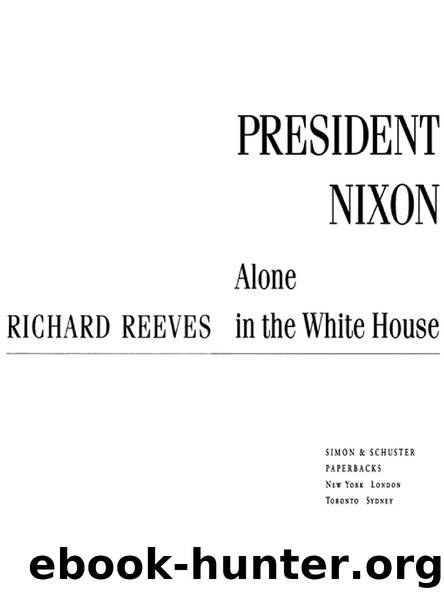President Nixon by RICHARD REEVES

Author:RICHARD REEVES
Language: eng
Format: epub
Publisher: SIMON & SCHUSTER PAPERBACKS
Published: 2001-07-15T00:00:00+00:00
CHAPTER 24
October 21, 1971
JOHN ANDREWS was the designated anecdotalist standing behind President Nixon on September 30 at a White House reception for finance ministers and other officials in Washington for the annual meetings of the World Bank and the International Monetary Fund. He filed a report that included:
One senses that he knows the political geography of the Planet Earth about as well as most Congressmen know their own districts. As the guests filed by, you got this kind of thing:
Man from Argentina: RN sings a few bars of their national anthem for Connally’s edification.
Man from Liberia: “I was just writing your President a letter today. We were Vice Presidents together, you know.”
For a change, though, the President was focused on domestic matters during the first couple of weeks of October: he was spending time on the Supreme Court nominations and preparing to announce “Phase II” of the New Economic Policy, the formation of a structure to deal with wage and price controls after the last day of the dramatic ninety-day price and wage freeze on November 13.
His first choice for the Supreme Court was a forty-seven-year-old congressman from Virginia, Richard H. Poff, the ranking Republican on the House Judiciary Committee. But Poff withdrew his name from consideration on October 2, after White House investigations came up with one thing after another that indicated a tough confirmation fight: Poff had voted against every civil rights bill introduced during his ten terms in the House, he had signed two antidesegregation manifestos, and he had trouble explaining how he had become rich on a congressman’s salary.
Nixon reacted to that by saying he still wanted to make a southern statement, telling Haldeman he wanted to find someone obviously to the right of Poff. Maybe they should try Robert Byrd. “He’s a real reactionary, the Democrats made him their whip,” said Nixon, “and he was in the Ku Klux Klan when he was young.” Send them a message.
The outline of Phase II, prepared by Herb Stein, was in shape by October 5 after hours of White House meetings between the President and most of the men who had been at Camp David in August. Stein’s memos to the President, revised and refined over several weeks, ended with these recommendations: “The basic Phase II structure would be three elements: The Cost of Living Council, with an executive director, exercising supervision of the entire program on your behalf…. A Tripartite Pay Board (public, labor and management) … A Commission on Prices, Costs and Profits consisting of public members only.”
The man who had the greatest influence on that structure was not in the room: George Meany. “A real patriot,” the President had called him when unions were supporting the war in Vietnam and attacking antiwar demonstrators. But the campuses were calm now—“Youth Rebellion of Sixties Waning” was the front-page headline of a New York Times survey of students—and that calm reduced the class resentment of workingmen. Labor leaders, including Meany, were back to focusing on economic issues and protecting the jobs of their members.
Download
This site does not store any files on its server. We only index and link to content provided by other sites. Please contact the content providers to delete copyright contents if any and email us, we'll remove relevant links or contents immediately.
| American Revolution | Civil War |
| US Presidents |
Fanny Burney by Claire Harman(26247)
Empire of the Sikhs by Patwant Singh(22772)
Out of India by Michael Foss(16695)
Leonardo da Vinci by Walter Isaacson(12809)
Small Great Things by Jodi Picoult(6689)
The Six Wives Of Henry VIII (WOMEN IN HISTORY) by Fraser Antonia(5240)
The Wind in My Hair by Masih Alinejad(4849)
The Crown by Robert Lacey(4577)
The Lonely City by Olivia Laing(4572)
A Higher Loyalty: Truth, Lies, and Leadership by James Comey(4555)
The Iron Duke by The Iron Duke(4125)
Millionaire: The Philanderer, Gambler, and Duelist Who Invented Modern Finance by Janet Gleeson(4106)
Sticky Fingers by Joe Hagan(3916)
Papillon (English) by Henri Charrière(3913)
Joan of Arc by Mary Gordon(3787)
Alive: The Story of the Andes Survivors by Piers Paul Read(3736)
Stalin by Stephen Kotkin(3728)
Aleister Crowley: The Biography by Tobias Churton(3428)
Ants Among Elephants by Sujatha Gidla(3282)
